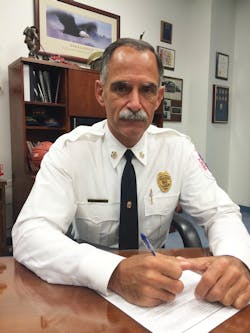We have SO MUCH work to do. At almost every turn, somebody or some entity is crying foul about the cost of fire protection. With these naysayers trying to strip or stall smoke alarm and sprinkler legislation, or downsize minimum staff requirements, or combine public safety duties, it seems that we in the fire and EMS community are constantly under proverbial attack.
I have had the good fortune to live and work in both a robust combination department serving nearly 1 million residents as well as a rural West Virginia all-volunteer county serving 12,000 residents. I have now settled for residence in Highlands County, FL, which has a mix of individual paid and volunteer services serving more than 100,000 full-time residents.
With respect to fire and EMS protection in the communities I have lived, one thing has been consistent: They all have it. That's about it for similarities.
This article will not be about the values or virtues of paid vs. volunteer vs. combination; that’s a discussion for another day. Today I’m considering how much our communities value their peace of mind. Put another way, what’s peace of mind worth to them? “Oh, chief, that’s ridiculous, they all know they need the fire department,” you are probably thinking. Really? Well, what’s your fire department look like? Is your community’s peace of mind built on what they know, or is the peace of mind built on the “it hasn’t happened to me” mentality?
Eye-opening conversations
Recently, I was speaking with a homebuilder who was mildly bemoaning the cost of an adjacent town’s fire engine: “$500,000 ... geesh, there’s not a building in town worth that much money.” It was a friendly conversation, which I initially blew off as idle chatter and uninformed minutia. As we talked a little further, he said, “Isn’t that what insurance is for?” As we continued to chat, it was clear he was somewhat passionate about the belief that because there was no building in town worth $500,000 (which I doubt is true), there was no viable explanation to spend that much money on a fire engine. Boy, we have a lot of work to do.
It’s easy for a builder to think, “Isn’t that what insurance is for?” After all, he’s going to get work out of it. Mind you, I don't suggest nor believe they wish any ill will on anyone; it is just their state of mind—much like the elected official’s state of mind is typically to save tax dollars.
As we circled into the “S” discussion, he said, “Why do we need sprinklers? Isn’t that what smoke alarms are for?” Again, I’m not suggesting any level of incompetence here—this is a smart guy—it’s just the mentality that smoke alarms are good enough, so let insurance take over after that. Boy, we have a lot of work to do.
The role of sprinklers
In 1992, Prince George’s County, MD, was the first county in the United States to mandate residential sprinklers in all new construction. We recently released Prince George’s County’s 25-year report on the 1992 mandate for residential sprinklers in all new construction. Following are some stats that show the differences between non-sprinklered and sprinklered construction over this 25-year period:
Non-sprinklered construction
- Fires in unprotected homes (older than 1992): +/- 7,000
- Deaths in unprotected home fires: 190
- Injuries in unprotected homes: +/- 400
- Average dollar loss in unprotected homes: $70,000 (per Prince George’s County Office of the Fire Marshal)
Sprinklered construction
- Fires where sprinklers activated: 750
- Deaths where sprinklers activated: 0 (yes, ZERO)
- Injuries where sprinklers activated: 25
- Average dollar loss in sprinkler protected homes: $12,000
Why wouldn't the building industry want to keep sprinklers out? Sprinkler installation costs ($1.31 per square foot1 that builders would charge buyers/developers) don’t even BEGIN to outweigh how much they’ll make having to rebuild a house lost in a fire ($12,000 vs. $70,000—do the math!). But hey, that's what insurance is for, right? (Long sigh, note satire.)
The “cost mentality”
I could end this article right here, but we still have to talk about the “cost mentality” pervading the minds of elected officials, members of the building industry and people within our communities. This really is the crux of the issue: How much is your fire/EMS peace of mind worth?
Elected officials are constantly struggling to make ends meet within their municipal budgets. I get it! It’s no different than any homeowner who has to stay “within their means.” Sometimes you have to sacrifice one thing to make some other thing work out. Is fire or EMS protection one of the things your community wants to sacrifice? I sure hope not, however, we see political attacks on fire/EMS budgets all the time.
And for those who say, “Make it all volunteer,” here’s a news flash: “Volunteer” does NOT mean “free.” Aside from equipment, supply and upkeep costs, what will potential reductions in response time or “numbers” of firefighters do to fire and life losses and insurance rates? We may not know until the next rating. Is it worth it? I think not. Additionally, volunteers in many areas receive length of service, insurance and medical coverage. Again, “volunteer” will save salary cost, but does not mean “free,” and it may or may not end up costing less.
So how about combining duties, for instance, having police officers be firefighters when there’s a fire? Well, why don’t we just have the banker be the barber when nobody’s at the bank? They could cut hair in a chair next to the vault and do teller duty in between clients. I mean, banking and barbering are two services that people need, right, so why not combine them? How silly is that? I usually hear these combining duty stories on the heels of budget-cutting drama, often fueled by industry (government and building) consultants’ reports or advice of how to “save.”
I fully support some level of cross-training and having disciplines HELP each other; however, training police officers to wear SCBA and switch “acts” in the middle of the show, at the expense of staffing on fire trucks, is dangerously irresponsible at best.
Truth tetrahedron
The community risk-reduction (CRR) tetrahedron relies on an effective level of prevention, education, preparation and response (PEPR). Having one or two of the four will not make the others just “happen” or become obsolete. Each of the PEPR levels will be necessary forever, and reducing injuries, deaths and dollar loss will ultimately be the result of effective CRR PEPR actions.
Whether commercial or residential, I suggest another tetrahedron, a no-nonsense/truth tetrahedron showing these four tenets: 1) Smoke alarms are only intended to give early notification of a smoke-event; 2) sprinklers are only intended to “knock down” a fire, providing enough time to get out and keeping a fire in check until firefighters arrive; 3) human escape planning will help humans gather their wits to get out, just in time to survive; and 4) the working combination of 1, 2, and 3 reduces loss of life and injury AND reduces property loss, ultimately reducing insurance losses (and thereby rates/premium needs) and lessens the economic impact to communities that have to rebuild.
Know the cost
NONE of this comes without a cost. Whether it’s one of finance or time, there will be a COST to provide and install smoke alarms and sprinklers. It will cost only time to plan your escape; it will cost money to provide fire protection, whether volunteer, paid or combination—and fire engines will cost the SAME, whether it’s a volunteer or paid staff.
We will spend time in another article focused on fire-based EMS services and address the myriad other services fire departments provide. But for now, consider these questions: Are the members of your community satisfied with their level of service and/or protection? Is their property worth it to them? Will your department be able to handle it? How much is YOUR life worth?
Reference
1. Newport Partners. Home Fire Sprinkler Cost Assessment. 2013. Quincy, MA: The Fire Protection Research Foundation.

Marc S. Bashoor
MARC S. BASHOOR joined the fire service in 1981. In 2017, he retired as fire chief of Prince George’s County, MD, Fire/EMS, the largest combination department in North America. His progressive community-based approach led to record hiring and a strategic apparatus replacement plan.
Twitter: @ChiefBashoor
Email: [email protected]






